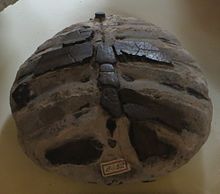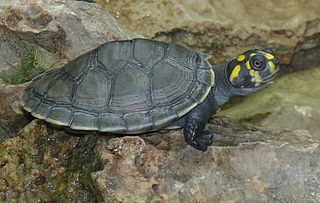
Podocnemididae is a family of pleurodire (side-necked) turtles, once widely distributed. Most of its 20 genera and 30 species are now extinct. Seven of its eight surviving species are native to South America: the genus Peltocephalus, with only one species ; and the genus Podocnemis, with six living species of South American side-necked river turtles. There is also one genus native to Madagascar: Erymnochelys, the Madagascan big-headed turtle, whose single species E. madagascariensis.

Uintatherium is an extinct genus of herbivorous dinoceratan mammal that lived during the Eocene epoch. Two species are currently recognized: U. anceps from the United States during the Early to Middle Eocene and U. insperatus of Middle to Late Eocene China.

Pneumatoarthrus is an extinct genus of sea turtle known from the Late Cretaceous Mount Laurel Formation of Monmouth County, New Jersey. Only a single species, P. peloreus, is known.
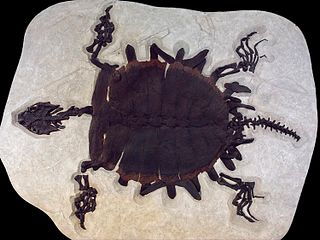
Axestemys is an extinct genus of softshell turtle that lived from the Late Cretaceous to the Eocene in western North America and Europe.

Limnofregata is an extinct genus of primitive frigatebird. The two known species were described after fossils from the Early Eocene Green River Formation of Wyoming. A number of good complete and partial skeletons, some with feather impressions, are known of the type species, Limnofregata azygosternon, and L. hasegawai is known from two skulls and most of one torso.

Protostega is an extinct genus of sea turtle containing a single species, Protostega gigas. Its fossil remains have been found in the Smoky Hill Chalk formation of western Kansas, time-equivalent beds of the Mooreville Chalk Formation of Alabama and Campanian beds of the Rybushka Formation. Fossil specimens of this species were first collected in 1871, and named by Edward Drinker Cope in 1872. With a total length of 3.9 metres (13 ft), it is the second-largest sea turtle that ever lived, second only to the giant Archelon, and one of the three largest turtle of all time along Archelon and Gigantatypus.
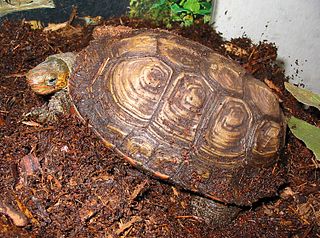
Rhinoclemmys is a genus of turtles in the family Geoemydidae, the only genus in the subfamily Rhinoclemmydinae. Member species of the genus are commonly known as the Neotropical wood turtles and are the only geoemydids known from the Americas. As such, they have adapted to a wide range of habitats, which is reflected in the species' common names.

Protostegidae is a family of extinct marine turtles that lived during the Cretaceous period. The family includes some of the largest sea turtles that ever existed. The largest, Archelon, had a head one metre (39 in) long. Like most sea turtles, they had flattened bodies and flippers for front appendages; protostegids had minimal shells like leatherback turtles of modern times.
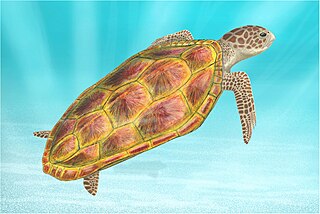
Santanachelys gaffneyi is an extinct species of sea turtle. It is the only species in the genus Santanachelys, which itself is a member of the extinct family Protostegidae. The species was first described from a 20-centimeter long fossil specimen unearthed in 1998 from the Santana Formation of eastern Brazil. From the rock layer from which it was excavated, it was determined that the specimen was from the Early Cretaceous period. It is therefore one of the oldest known sea turtles. but a new fossil named Desmatochelyspadillai in 2015 is estimated to be as old as 120 million years.

The Fur Formation is a marine geological formation of Ypresian age which crops out in the Limfjord region of northern Denmark from Silstrup via Mors and Fur to Ertebølle, and can be seen in many cliffs and quarries in the area. The Diatomite Cliffs is on the Danish list of tentative candidates for World Heritage and may become a World Heritage site. Fossils found in the Fur Formation are primarily housed at the Fossil and Mo-clay Museum on Mors Island, the Fur Museum on Fur Island, and the Natural History Museum of Denmark in Copenhagen.

Ctenochelys is an extinct genus of marine turtle, which existed during the Cretaceous period, and lived in the shallow waters of the Western Interior Seaway. Its fossils have been found in the Ripley Formation and Mooreville Chalk of central Alabama, United States. It was first named by C. H. Sternberg in 1904, and contains two species, C. stenoporus and C. acris.
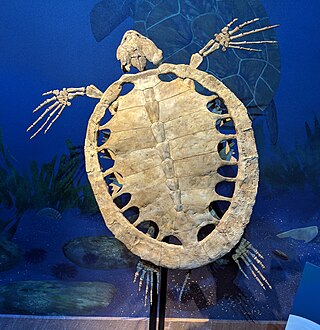
Euclastes is an extinct genus of sea turtles that survived the Cretaceous–Paleogene mass extinction. The genus was first named by Edward Drinker Cope in 1867, and contains three species. E. hutchisoni, was named in 2003 but has since been reassigned to the genus Pacifichelys, while E. coahuilaensis named in 2009 was reassigned as Mexichelys coahuilaensis in 2010.
Itilochelys is an extinct genus of sea turtle in the family Cheloniidae containing the single species Itilochelys rasstrigin. The species is known only from the Early Paleocene, Danian stage Rasstrigin 2 locality, Dubovsky District, Volgograd Oblast, Russia.

Trionyx is a genus of softshell turtles belonging to the family Trionychidae. In the past many species in the family were classified in this genus, but today T. triunguis, the African or Nile softshell turtle, is the only extant softshell still classified as Trionyx. The other species still assigned to this genus are only known from fossils. T. triunguis is a relatively large, aquatic piscivore.

Pancheloniidae is a clade of sea turtles It is defined as all turtles more closely related to cheloniid sea turtles than to dermochelyid ("leatherback") sea turtles.
Plesiocetus is a genus of extinct balaenopterids found worldwide. It has had a chequered taxonomic history, having served as a wastebasket genus for a handful of mysticete species.

Tasbacka is an extinct genus of sea turtle containing several species.

Drazinderetes is a large bodied genus of soft shell turtle from the Middle Eocene Drazinda Formation of Pakistan. Its presence in the shallow marine deposits of the Drazinda Formation suggests that Drazinderetes may have been a partially or fully marine animal. Indetermined trionychine remains from the same formation may suggest that Drazinderetes could have been among the largest known turtles, with one entoplastron indicating a potential length of 1.5 to 2.1 meters. Drazinderetes currently consists of only a single species: Drazinderetes tethyensis.

Erquelinnesia is an extinct turtle genus from the Cretaceous period, which has been found in fossils. Paleontologist Louis Dollo first described this genus late 19th century from fossilized samples found in the layers of Upper Paleocene / Lower Eocene in Hainaut, Belgium,. Erquelinnesia lived between the Upper Cretaceous and Lower Paleocene ( Danian. Louis Dollo named his discovery as Pachyrhynchus gosseleti in 1886. However, in the following year, the nomenclature was changed by Dollo to Erquelinnesia gosseleti to resolve a conflict with another already existing generic name. Moreover, an additional species was attributed to the genus Erquelinnesia. The North American species called Erquelinnesia molariathat was known only from a fossilized mandible bone has subsequently re-categorized to the genus Euclastes.
Ischyrotherium is an extinct genus named by Joseph Leidy in 1856 for fossils from the lignite deposits in Nebraska. Originally considered an herbivorous cetacean, Leidy then reassigned it to Sirenia as a relative of manatees, before Edward Drinker Cope reclassified it as a non-mammalian, suggesting the new name Ischyrosaurus to better identify its reptilian origins, as he considered it a sauropterygian. Ischyrotherium was found alongside material from the hadrosaur Thespesius and turtles Compsemys and Emys, and the fish Mylognathus. The name Ischyrosaurus was also used by John Whitaker Hulke for the sauropod now known as Ornithopsis manseli, as he was unaware it was preoccupied by Cope.
